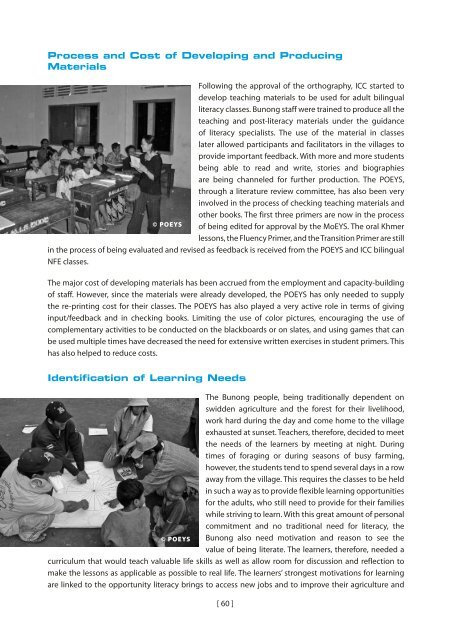Mother Tongue-based Literacy Programmes: Case Studies of Good ...
Mother Tongue-based Literacy Programmes: Case Studies of Good ...
Mother Tongue-based Literacy Programmes: Case Studies of Good ...
You also want an ePaper? Increase the reach of your titles
YUMPU automatically turns print PDFs into web optimized ePapers that Google loves.
Process and Cost <strong>of</strong> Developing and ProducingMaterialsFollowing the approval <strong>of</strong> the orthography, ICC started todevelop teaching materials to be used for adult bilingualliteracy classes. Bunong staff were trained to produce all theteaching and post-literacy materials under the guidance<strong>of</strong> literacy specialists. The use <strong>of</strong> the material in classeslater allowed participants and facilitators in the villages toprovide important feedback. With more and more studentsbeing able to read and write, stories and biographiesare being channeled for further production. The POEYS,through a literature review committee, has also been veryinvolved in the process <strong>of</strong> checking teaching materials andother books. The first three primers are now in the process© POEYS <strong>of</strong> being edited for approval by the MoEYS. The oral Khmerlessons, the Fluency Primer, and the Transition Primer are stillin the process <strong>of</strong> being evaluated and revised as feedback is received from the POEYS and ICC bilingualNFE classes.The major cost <strong>of</strong> developing materials has been accrued from the employment and capacity-building<strong>of</strong> staff. However, since the materials were already developed, the POEYS has only needed to supplythe re-printing cost for their classes. The POEYS has also played a very active role in terms <strong>of</strong> givinginput/feedback and in checking books. Limiting the use <strong>of</strong> color pictures, encouraging the use <strong>of</strong>complementary activities to be conducted on the blackboards or on slates, and using games that canbe used multiple times have decreased the need for extensive written exercises in student primers. Thishas also helped to reduce costs.Identification <strong>of</strong> Learning NeedsThe Bunong people, being traditionally dependent onswidden agriculture and the forest for their livelihood,work hard during the day and come home to the villageexhausted at sunset. Teachers, therefore, decided to meetthe needs <strong>of</strong> the learners by meeting at night. Duringtimes <strong>of</strong> foraging or during seasons <strong>of</strong> busy farming,however, the students tend to spend several days in a rowaway from the village. This requires the classes to be heldin such a way as to provide flexible learning opportunitiesfor the adults, who still need to provide for their familieswhile striving to learn. With this great amount <strong>of</strong> personalcommitment and no traditional need for literacy, the© POEYS Bunong also need motivation and reason to see thevalue <strong>of</strong> being literate. The learners, therefore, needed acurriculum that would teach valuable life skills as well as allow room for discussion and reflection tomake the lessons as applicable as possible to real life. The learners’ strongest motivations for learningare linked to the opportunity literacy brings to access new jobs and to improve their agriculture and[ 60 ]

















